I predict that the first time most people notice that big flocks of crows are back in town will be during evening rush hour on Monday November 5.
Can you guess why?
(video of the flock in December 2010 by Sharon Leadbitter)
I predict that the first time most people notice that big flocks of crows are back in town will be during evening rush hour on Monday November 5.
Can you guess why?
(video of the flock in December 2010 by Sharon Leadbitter)
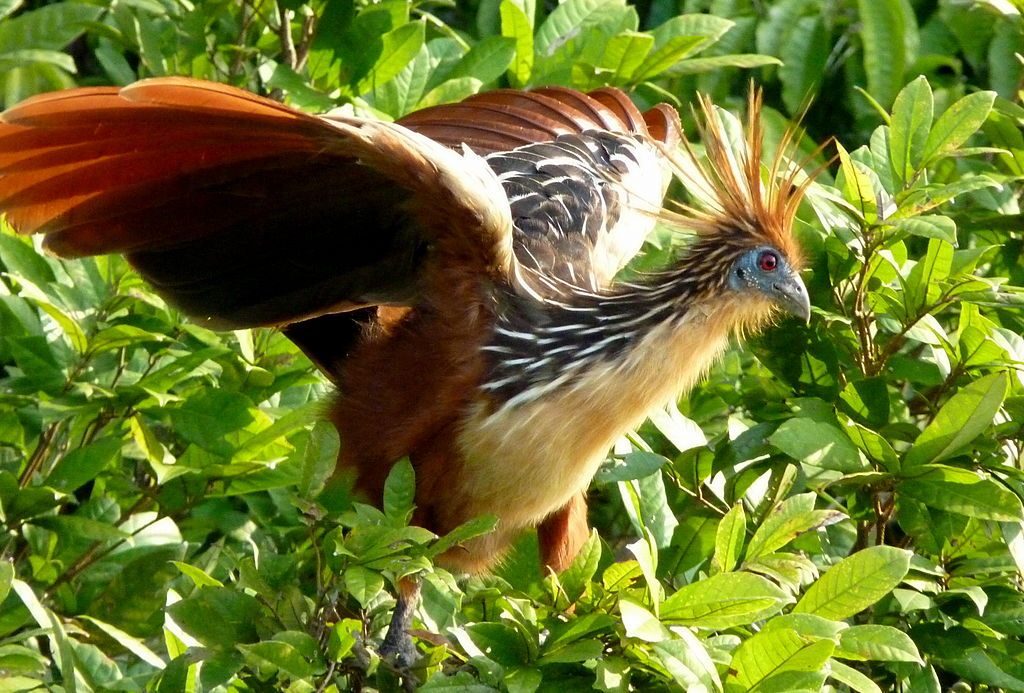
Here’s a bird so unusual that it has no living relatives. It is the only species in its genus, family and order. Even with DNA evidence scientists have found nothing quite like it. The best they can say is that Opisthocomus hoazin is … a bird.
The hoatzin (pronounced “watson”) is a noisy, colorful, pheasant-sized bird that lives in the swamps and river forests of the Amazon and Orinoco basins in South America. Like herons it nests communally in trees or shrubs over water. But unlike any other bird the hoatzin eats leaves almost exclusively. Leaves are 82% of its diet.
Leaves are not very nutritious and require bacterial fermentation to digest them. Leaf-eating mammals (cattle, sheep, goats) have a rumen for that purpose. Hoatzins have a huge crop that does the job, but it’s so large and heavy that the birds are clumsy in flight.
Fortunately, they don’t need to fly to escape. The fermentation in their crops is so foul that adult hoatzins smell like manure. Few animals want to eat them.
Hoatzin eggs and young are preyed upon but the young have unique escape tools. Before they grow flight feathers they have claws on the thumb and forefinger of each wing — like dinosaurs! When danger threatens they drop from the nest into the water below, swim away and then climb back to the nest using their finger and toe claws.
Since people rarely hunt them, hoatzins seem tame and are easy to find.
Stinky bird in the Amazon jungle gloom? It’s a hoatzin, I presume.
(photo from Wikimedia Commons. Click on the caption to see the original)
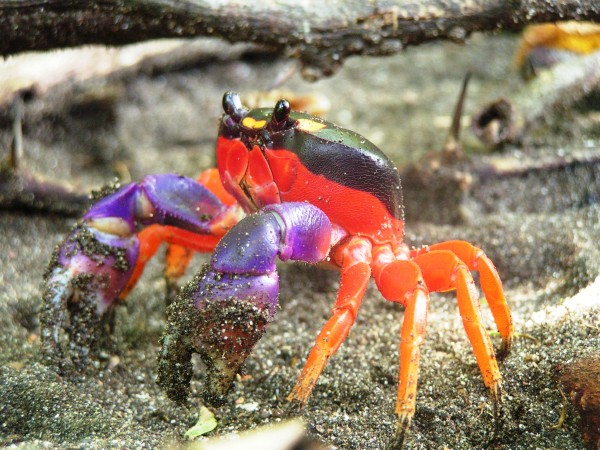
In honor of the day here’s a critter whose name is Halloween.
Red land crabs, also called harlequin or Halloween crabs (Gecarcinus quadratus), are nocturnal burrowing crabs that live on the Pacific coast from Mexico to Peru. They spend their lives in sand dunes, moist forest or mangroves but they need the ocean to reproduce so they don’t stray far from shore.
From above these crabs look black and orange. They’re even more colorful from the side.
Trick or Treat!
(photo from Wikimedia Commons. Click on the image to see the original)
p.s. As Hurricane Sandy approached Pittsburgh on Monday many municipalities rescheduled Trick-or-Treat to Saturday Nov 3, so there will be no costumed kids at our door tonight. Kind of odd considering everything in Pittsburgh is just fine. Not so in New York City where our nephew reports he was not flooded but has no electricity.

30 October 2012
Last night as Hurricane Sandy approached Pittsburgh I thought about the birds. Where will they hide from the storm? I knew the answer but I wanted assurance.
Birds already know how to cope with bad weather. Each species uses its own strategy to survive.
Birds that live on cliffs or buildings, like the pigeons above, shelter out of the wind and find the driest possible place to wait out the storm. This doesn’t always keep them dry but it keeps them safe.
Birds that roost in cavities, such as woodpeckers, owls, house sparrows and starlings go indoors during bad weather. Sometimes more than 10 bluebirds will huddle together inside a bluebird box, using their communal body heat to stay warm.

Robins, sparrows and cardinals roost in thickets and hunker down close to the ground when it’s windy. If you have a brush pile, as Marcy Cunkelman does, the birds will hide there from bad weather and predators. The Coopers hawk happens to know this, too.

Shorebirds and ocean birds fly inland, ducks find sheltered lakes or rivers. Yesterday afternoon as Hurricane Sandy raged across Pennsylvania (29 October 2012) Shannon Thompson found huge numbers of waterfowl sheltering at Greenlick Run Reservoir in Fayette Country. Thousands of birds had stopped there to wait out the storm including snow geese, brants, tundra swans, and nearly 5,000 ruddy ducks.
Every species has a strategy. I’m sure most of them made it through last night’s wind in Pittsburgh. So did we. The electricity is still on!
For more information, including stories of birds flying in the eye of the storm, see this excellent article from the National Wildlife Federation written in response to Hurricane Irene. It explains what happens to wildlife under these circumstances.
(pigeon photo from Wikimedia Commons, click on it to see the original. Bluebird and Coopers hawk photos by Marcy Cunkelman)
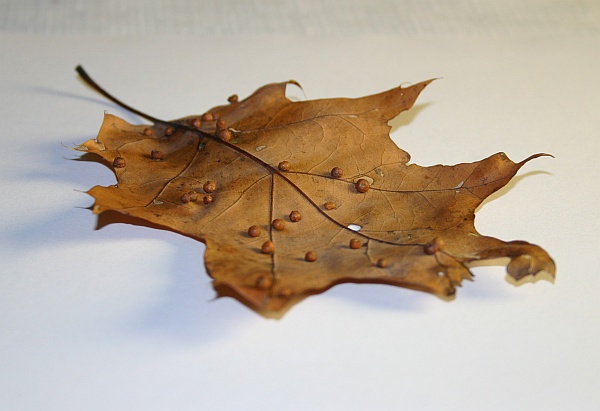
Before the rain began on Saturday I took a walk in Schenley Park to check on the birds.
In addition to a flock of thousands of robins and starlings near Anderson Playground, I found American goldfinches foraging high in a stand of red oak trees. They seemed to be picking things off the backs of the leaves. At ground level I heard the sound of raindrops ticking on the dry leaf litter — but it wasn’t raining. The goldfinches were dropping the shells.
I collected a leaf and took its picture. Here you see the brown bumps the goldfinches were cracking open. They look like tiny acorns.
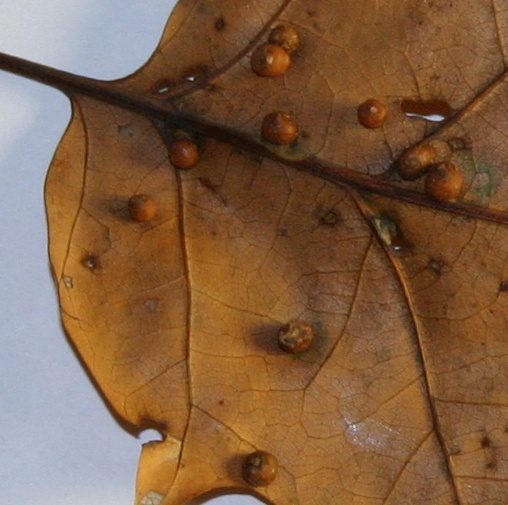
In fact, they’re galls. When I searched the web to identify them, I learned from the University of Minnesota’s Department of Entomology that there are more than 700 species of gall-forming insects in the US and Canada and 80% of them use oaks (read about it here).
Galls form when tiny insects lay their eggs on live leaves (not these dried brown leaves). The eggs emit chemicals that stimulate the leaves to grow covers around the eggs. This protects the larvae until they’re ready to emerge — unless a goldfinch finds them.
Were these galls made by cynipid wasps that are very common on oaks? I thought so at first(*) but …
On 12 Dec 2012, Charley Eiseman at BugTracks corrected my original theory about the galls. He wrote: “I believe these are actually among the few oak galls that are not caused by cynipid wasps – they look to me like the work of Polystepha globosa, a midge (Cecidomyiidae).” This link has more information about the midge.
Thanks to the goldfinches I learned something new.
(photos by Kate St. John)
(*) My original theory was that these were cynipid wasp galls, made by very tiny wasps that are harmless to humans. They lay their eggs on oak leaves. Each species uses a different site on the oak (root, twig, leaf) and specializes in particular species of oaks. The most amazing cynipid wasp is the one that becomes the jumping oak leaf gall.
The blue-crowned motmot is a colorful Central and South American bird with a striking face and red eyes. The male also has two unusual tail feathers with bare shafts and racket tips. Racket… as in tennis racket.
The feathers don’t start out this way. When the male molts the feathers grow in normally but the middle radii are weakly attached to the shaft so they easily fall off during normal abrasion and preening. The result is a fancy tail during the breeding season.
In the wild, the racket tips are very noticeable because the males swings his tail like a pendulum when disturbed.
Want to see a blue-crowned motmot in Pittsburgh? Visit the National Aviary.
(photo from Wikimedia Commons. Click on the image to see the original)
I had no idea Asian lady beetles came in so many colors and patterns.
Yes, they’re annoying, but in this composite close-up they’re actually pretty.
(photo by @entomart on Wikimedia Commons. Click on the image to see the original)
26 October 2012
Just out last week, this short video is a gorgeous introduction to the Birds-of-Paradise Project.
For the past eight years Cornell Lab’s Ed Scholes and National Geographic’s Tim Laman collaborated to film all 39 species of the birds-of-paradise. Their goal was to probe the mystery of the birds’ evolution and to bring attention to their conservation needs.
How did the birds and their dances become so exotic? It’s as if they were selectively bred for the most elaborate dances and fancy plumes.
And they were.
Just like our experience of selectively breeding dogs into specialized traits and sizes (think Irish wolfhound and dachshund), the female birds-of-paradise have always selected the fanciest males with the best dances. And then they breed.
Watch the video of these amazing birds and check Cornell Lab’s resource link for the upcoming book and broadcast.
(video from Cornell Lab of Ornithology and National Geographic via YouTube)
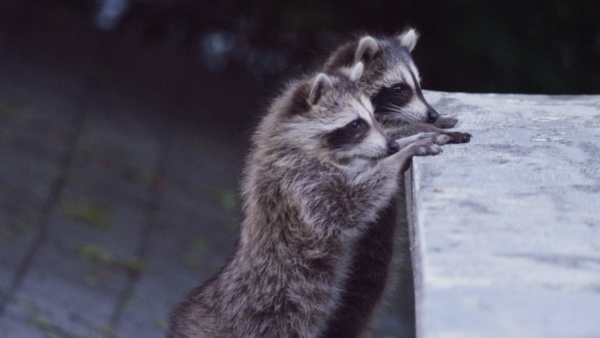
Somehow I missed Raccoon Nation! when it premiered on PBS NATURE in February 2012 but Oh, my! I watched it online last week and I can hardly wait to see it on the big screen when PBS re-broadcasts it on Halloween 2012.
I’ve already learned that raccoons are the smartest animal in the urban jungle. They’re relatively small (so it’s easy to hide), nocturnal, omnivorous and adaptable. They learn from their mothers and they can get into anything because they have thumbs.
I’ve seen this in my city neighborhood: a mother raccoon guiding her kits to shelter, the sound of raccoons arguing over my neighbor’s bird feeders at night, the shadows of ‘coons raiding my bird bath.
There’s not a garbage can they can’t open. They’re ready for any challenge. And our attempts to outsmart them make them smarter!
So of course I’m going to pull up a seat on Wednesday 31 October 2012 at 8:00pm and watch Raccoon Nation! in living color on WQED.
I can hardly wait. On Halloween the animals will wear masks.
(photo from PBS NATURE)
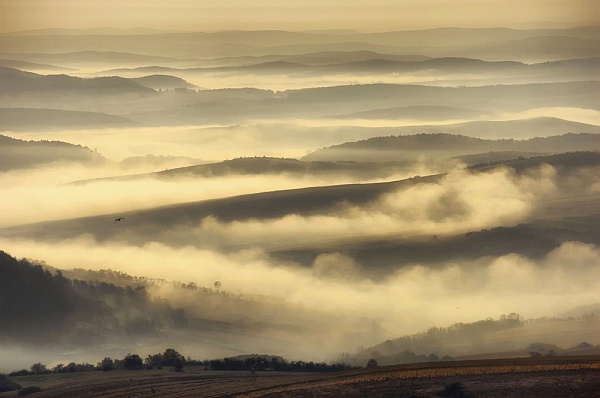
24 October 2012
“Radiation fog” sounds scary but it’s actually the kind of fog we get in Pennsylvania at this time of year. We often see it in the early morning below our hawk watch sites. (Can you see the bird in this picture?)
It forms when winds are calm overnight while the land cools. The land’s thermal radiation lowers the air temperature and condenses moisture into fog that usually evaporates in the morning.
In hilly country it’s called “valley fog” and is more pronounced because the topography traps cold air in the valleys with warm air overlaying it in a temperature inversion.
Like fog, inversions are also common in southwestern Pennsylvania in fall and winter. They can be deadly when air pollution is involved. The famous Donora Smog occurred during a five day inversion in 1948, October 27 to 31. It killed 20 people and 800 animals immediately, sickened 7,000, raised the mortality rate in Donora for at least a decade, and lowered property values (who would want to live there after that!).
Inversions still occur but our air is cleaner.
Nowadays we take for granted that our laws will protect us from air pollution. Unfortunately the laws could be weakened because companies complain it costs money to avoid killing or sickening us.
Without protection from air pollution, the fog would be scary after all.
(photo from Shutterstock)